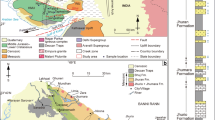Abstract
The Early Cambrian continental Khewra Sandstone, Salt Range, Pakistan consists of lithics, feldspar and quartz in order of increasing abundance. Both mono- and polycrystalline quartz are observed. The feldspar is predominantly plagioclase and potassium feldspar; lithics represented are of sedimentary, metamorphic and igneous origin. Accessory minerals present include micas (muscovite and biotite), opaque mineral grains, zircon, rutile, epidote, glauconite, chlorite and monazite. Ferruginous clays are present as matrix and the major cements are calcareous, siliceous and ferrous. The sandstone is grain supported, moderate to well sorted and rounded to well rounded with medium to high sphericity. Overall, the sandstone is texturally and mineralogically mature and is classified as sub-arkose and quartz arenite. Provenance from cratonic interior and recycled orogeny and the paleoflow indicate source from southeast. Petrographic analysis and field characteristics of the sandstone indicate that the source areas were characterized by uplift of high relief continental block. The rocks weathered from the source areas primarily included granites, together with metamorphic basement and sedimentary rocks. Regional palaeogeographic reconstructions indicate that the Khewra Sandstone detritus was derived from the Indian Craton to the south and southeast. The southeastern source area of the Khewra Sandstone attests to the Pan-African orogeny (∼500 ± 25 Ma) and contemporaneous large-scale diastrophism, which resulted in Gondwanic India upheaval, providing source for the Cambrian Khewra Sandstone of the Salt Range, Pakistan.












Similar content being viewed by others
References
Baqri SRH, Baloch MQ (1991) Sedimentological studies and palaeoenvironments of Khewra Sandstone with reference to its hydrocarbon potential. Pak J Pet Technol Islam 1:23–38
Blakey RC (2008) Gondwana paleogeography from assembly to breakup—a 500 m.y. odyssey. Geol Soc Am Spec Pap 441:1–28
Boggs Jr. JS (1987) Principles of sedimentology and stratigraphy. Merrill Publ Company Columbus Ohio, pp 1–784
Dickinson WR, Suczek CA (1979) Plate tectonics and sandstone compositions. Am Ass Petrol Geol Bull 63:2164–2182
Dickinson WR, Beard LS, Brakenridge GR, Erjavee JR, Ferguson RC, Inman KF (1983) Provenance of North American Phanerozoic sandstones in relation to plate tectonic setting. Geol Soc Am Bull 94:222–235
Fatmi AN (1973) Lithostratigraphic units of the Kohat-Potwar Province, Indus Basin, Pakistan. Geol Surv Pak Mem 10:1–80
Fischer RV (1961) Proposed classification of volcaniclastic sediments and rocks. Geol Soc Am Bull 72:1409–1414
Folk RL (1954) The distinction between grain size and mineral composition in sedimentary rock nomenclature. J Geol 62:344–359
Franzinelli E, Porter PE (1983) Petrology, chemistry and texture of modern river sands, Amazon river system. J Geol 91:23–39
Ingersoll RV, Suczek CA (1979) Petrography and provenance of Neogene sand from Nicobar and Bengal fans. Deep sea drilling project sites 211 and 218. J Sediment Petrol 49:1217–1228
Jan IU, Stephenson MH (2011) Palynology and correlation of the Upper Pennsylvanian Tobra Formation from Zaluch Nala, Salt Range, Pakistan. Palynology 35(2):212–225
Kazmi AH, Abbasi IA (2008) Stratigraphy and historical geology of Pakistan. National Centre of Excellence in Geology. University of Peshawar, Peshawar, pp 1–210
Mack GH (1984) Exceptions to the relationship between the plate tectonics and sandstone composition. J Sediment Petrol 54:212–220
McBride EF (1963) A classification of sandstones. J sediment Petrol 33:664–669
Noetling F (1894) On the Cambrian formations of the eastern Salt Range. Geol Surv India Rec 27(4):71–86
Okada H (1971) Classification of sandstone, analysis and proposal. J Geol 79:509–525
Pettijohn FJ, Potter PE, Siever R (1987) Sand and sandstone. Springer, NY, pp 1–559
Potter PE (1978) Significance and origin of Big Rivers. J Geol 16:13–33
Raja BA, Hussain M, Akbar G (1975) The paleocurrent orientation and the source determination study of the Khewra Sandstone in the Eastern part of Salt Range (Pakistan). Unpublished M.Sc Thesis, University of Peshawar, pp 1–60
Schindewolf OH, Seilacher A (1955) Beitrage zur Kenntnisdes Kambriums in der Salt Salt Range, Pakistan. Akad Wiss Lit (Mainz) Abh Math-naturw KI 10:1–190
Shah SMI (1980) Stratigraphy and economic geology of central Salt Range. Geol Surv Pak Rec 52:1–104
Suttner LJ, Basu A, Mack GH (1981) Climate and the origin of quartz arenites. J Sediment Petrol 51:1235–1246
Tanoli SK, Haneef M (1988) A paraconformity in the Cambrian sequence of the Salt Range. Geol Bull Univ Peshawar 21:167–168
Terry RD, Chilingar GV (1955) Summary of “concerning some additional aids in studying sedimentary formations”. J Sediment Petrol 25:229–234
Valdiya KS (1997) Himalaya, the Northern Frontier of East Gondwanaland. Gondwana Res 1(1):3–9
Veevers JJ (2004) Gondwanaland from 650–100 Ma assembly through 320 Ma merger in Pangea to 185–100 Ma breakup: supercontinental tectonics via stratigraphy and radiometric dating. Earth Sci Rev 68:1–132
Williams H, Turner FJ, Gilbert CM (1954) Petrography. Freeman, San Francisco, p 406
Wynne AB (1878) On the geology of Salt Range in Punjab. Geol Surv India Mem 14:313
Young SW (1976) Petrographic textures of detrital polycrystalline quartz as an aid to interpreting crystalline source rocks. J Sediment Petrol 46:595–603
Acknowledgments
This research work was funded by the National Centre of Excellence in Geology, University of Peshawar
Author information
Authors and Affiliations
Corresponding author
Appendices
Appendix-1
Appendix-2
Appendix-3
Appendix-4
Rights and permissions
About this article
Cite this article
Jehangiri, M., Hanif, M., Arif, M. et al. The Early Cambrian Khewra Sandstone, Salt Range, Pakistan: endorsing southern Indian provenance. Arab J Geosci 8, 6169–6187 (2015). https://doi.org/10.1007/s12517-014-1649-7
Received:
Accepted:
Published:
Issue Date:
DOI: https://doi.org/10.1007/s12517-014-1649-7




